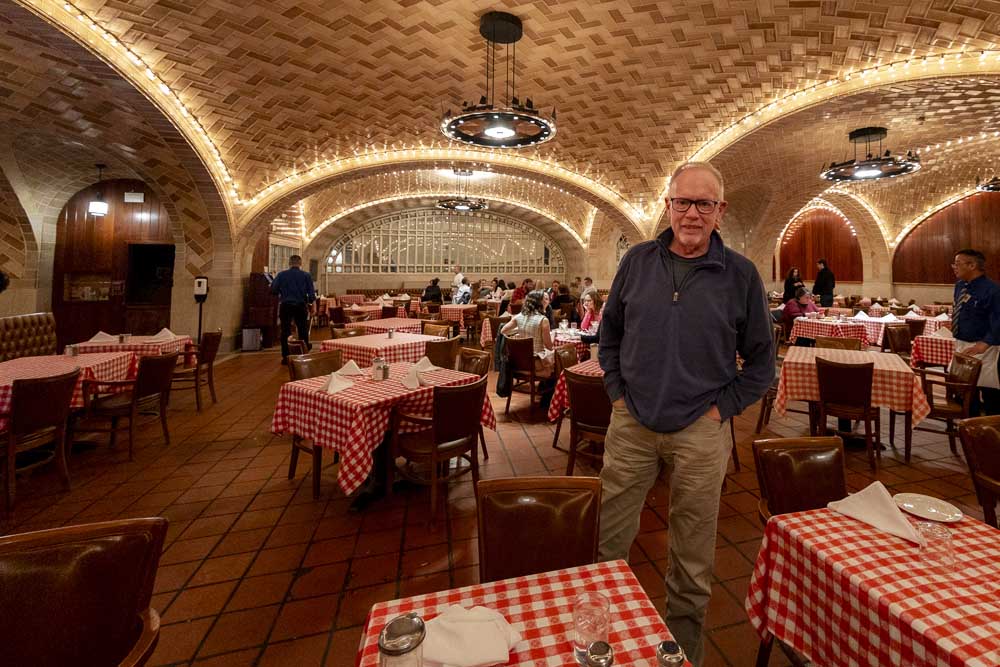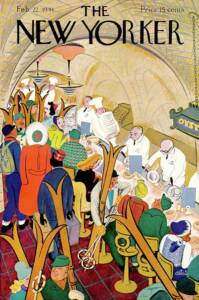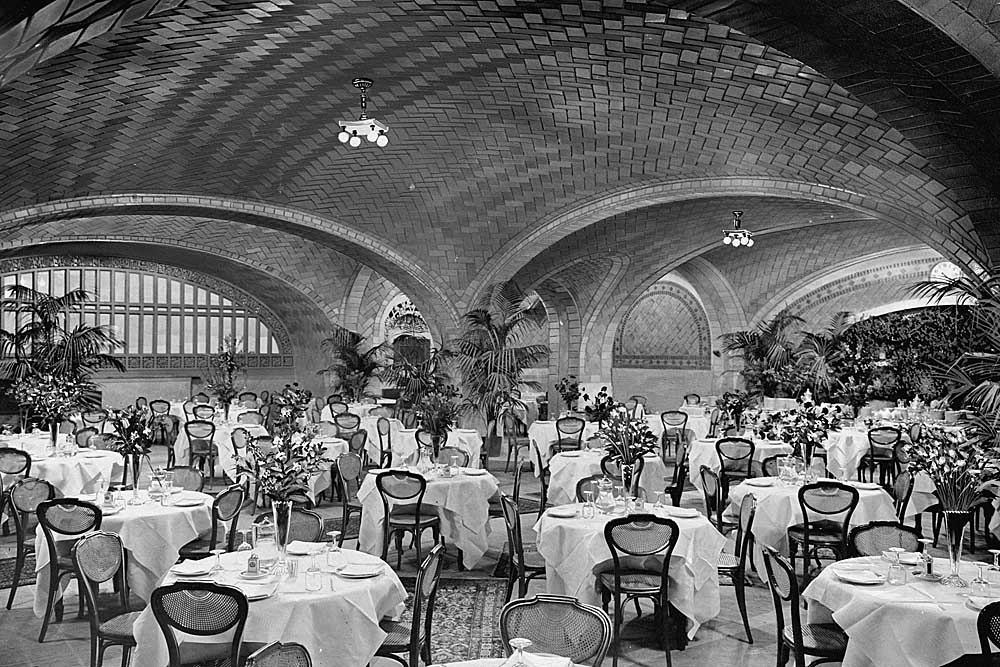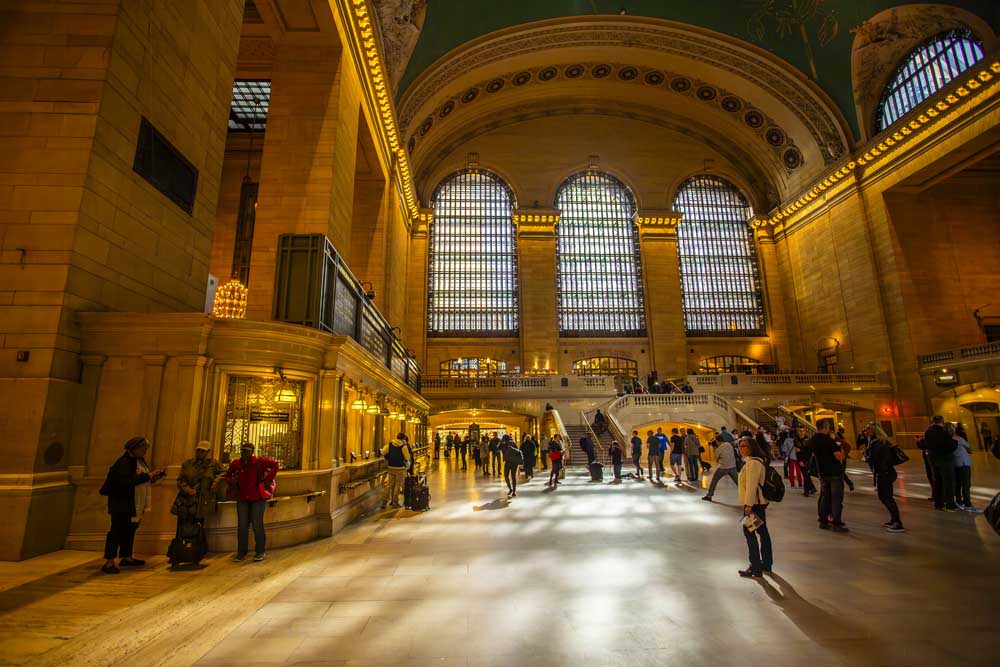
I don’t keep bucket lists, but one thing I’d been hoping to visit one day was the famed Oyster Bar, the historic restaurant that’s been operating in the catacombs of New York City’s Grand Central Terminal nearly continuously for 110 years. I finally got my chance a couple of weeks ago during a short research trip to Manhattan.
The Oyster Bar is worth trying for any number of reasons. For one thing, it’s a terrific restaurant, especially if you like seafood. And oysters of course, raw or cooked. For another, it’s a legendary restaurant on the New York scene, as famous in its own way as Sardi’s or Katz’s Delicatessen. Most of all for me, literally a card-carrying New York Central fan (member No. 7239 in the NYCSHS, thank you very much), the Oyster Bar is a reminder of the greatness of the Water Level Route.
Not that the NYC had direct involvement in the operation of the Oyster Bar, but the fact is the railroad’s architects — Reed & Stem and, supplementally, Warren & Wetmore — provided for the restaurant space, and generously so. No wonder generations of New Yorkers and travelers have fallen in love with the place. I daresay it’s as revered as that icon of the GCT concourse, the Information Booth.
Over the years, the Oyster Bar has seen small changes in menus, in ownership, and in décor. When it first opened, the linen tablecloths, sparkling glassware, and palm fronds were signs of a first-class eatery. Things are more casual now, with tables covered in red-and-white checkered oilcloth. But the essence of the restaurant is the same.

First known as the Grand Central Terminal Restaurant, at some point later it received its more famous name. The Oyster Bar gradually became part of New York lore. Celebrities frequented its bar, untold millions of travelers grabbed a bite to eat before grabbing a train for Poughkeepsie or Cincinnati, and, as if to officially sanctify the place, The New Yorkermagazine hired an artist to depict the restaurant for the Feb. 22, 1941, cover, featuring a lot of skiers obviously ticketed for NYC’s next train to Lake Placid.
The magazine still loved the restaurant some 77 years later when writer Oli Coleman extolled its virtues in a 2018 piece in The New Yorker’s Annals of Gastronomy. “The Oyster Bar has always been a good place for visitors to get an idea of the city,” Coleman wrote. “It’s fast. It’s loud. It’s abrupt. It’s big — two large dining rooms, a lounge, and a series of low lunch counters — yet it’s a crush: by the time you have hinged and folded into a seat at the counter, you will almost certainly have pressed your body against the body of your neighbor, who is a stranger and will likely remain so, although you will soon know his or her business. The space, like Grand Central as a whole, is ingeniously simple yet gorgeous, impatiently glamorous.”
I allowed myself to feel slightly glamorous as I met my dinner companion on a recent Thursday evening. Waiting for me was my friend Dennis Livesey, the noted photographer and author and bona fide New Yorker. Dennis is known for his dramatic images of contemporary steam, and his depictions of railroading around Manhattan — both transit and heavy rail — are nonpareil. That’s especially true for his photographs of Grand Central, one of his frequent muses.
I arrived a bit past the peak dinner hour, but the huge dining room and its long raw bar were still mostly full and buzzing. After studying the impossibly big menu for a while — it’s hard to imagine any kind of seafood that isn’t offered — we both settled on pan-fried trout, a pair of generous filets, prepared perfectly.
Then I took in a moment to study the surroundings. The Oyster Bar, like GCT itself, gives you a wonderful sense of place, a feeling you’re really arrived. Some of that is due to the attentive, uniformed staff. But what really gets your attention is the spectacular ceiling, actually a series of vaulted arches clad in the Gustavino tile system, which uses interlocking terracotta tiles as beautiful as they are functional. The ceiling looks the same as it did when the restaurant welcomed special guests on Feb. 1, 1913 — a day before the rest of the terminal opened.

Our dinner gave Dennis and I a chance to talk about how much we both love GCT. I’ve been to Grand Central countless times over the years, usually just to walk through it but occasionally to catch a Metro-North train. On one lucky evening in 1977, I even caught a roomette on Amtrak No. 49, the Lake Shore Limited, back when GCT still was an intercity station.
But I’m a piker compared with Livesey, a Manhattan resident whose bond with Grand Central is especially close. After dinner he gave me an excellent tour of the place. We reveled in the vast spaces, the rhythm of hurried steps on the marble, and the echoed murmur of hundreds of voices. Dennis has just the right words for the feeling.
“When you arrive at Grand Central, you know you have arrived at a great metropolis,” he told me later. “But further than that, while you know you are in an important city, the building makes YOU important. You can start your time in New York with drive and purpose. Nothing can stop you or your dreams.”
That’s the perfect word, Dennis: dreams. Later that evening, as the crowds thinned and we made our way over to the west end of the concourse to Track 34, where the Century customarily departed, I imagined a similar evening 70 years ago. The terminal is getting quiet and I’m waiting to board train 59, the Chicagoan, the 10:10 p.m. departure for Detroit. The fact the dining car will be closed for the evening doesn’t matter: I ate at the Oyster Bar.















Mr. Cafarella:
Next time you head to the Oyster Bar, instead of dining in
the “main” dining room, head to “The Saloon” in the back.
Great bar, lots of tables, and much, much quieter. You’ll
not get a headache but you will still leave full.
I work in the building right next to Grand Central and have gone to the Oyster Bar many times. I like everything about it except for one thing…the acoustics…. You can literally hear every conversation in the restaurant because of the way the ceiling is shaped. I always come out of there with a full belly and a massive headache!
Trout is good, but how can you miss the magic of sitting at the Oyster Bar and watch the chefs prepare the ultimate Oyster Pan Roast and a cold Heinichen. The ceiling tiles had to be recreated perfectly after a disastrous fire many years ago, hard to see the difference. Finally have you tried the whispering arch at the restaurant entrance. Every aficionado and kid worth his salt never ceases to enjoy the amazing experience of the sound phenomena.
I know Kevin’s story was posted a few days ago, but I just read it this morning. The interesting thing is, just last evening it popped into my head that it has been way to long since I last ate at the Oyster Bar. I was never a regular, but I had lunch there sometimes when I as a young sales rep in Manhattan selling logistics services for a container carrier back in the late 80’s. It was always a bustling place and full of energy. I never took a train to/from GCT, but I passed thru it all the time as it was and still is a major subway stop. I never missed a chance to walk through the main concourse – always a thrill. I often finished my day near GCT, so it was the #4 or #5 subway express downtown to City Hall/Brooklyn Bridge, and then three more stops to Bowling Green station for a couple minutes walk to the Staten Island Ferry.
Kevin you write so well. You gather facts, make them building blocks, and connect them into the most satisfying of stories. The reader is not only the recipient of interesting information, they walk away feeling good. That is talent.
Thanks for dinner!
Thanks Kevin, you’ve now given me a VALID reason to hop on the next Northbound out of Baltimore, it’s been WAY too long since I stopped in to the Oyster Bar.
I LOVE the Oyster Bar! I worked for the late, great New York Central and have dined there many times. I always enjoy the exciting, busy vibe at lunchtime. And, yes, I have departed GCT on the great “20th Century Limited” from track 34. By the way, the Oyster Bar serves the best oyster stew in the world!
There are a few places every railfan should visit in their lifetime – GCT is one that should not be missed. Thanks be to Jackie Kennedy and others who pushed for its preservation so it would did not go the way of Pennsylvania Station. I’ll be sure to hit the Oyster Bar on my next visit!